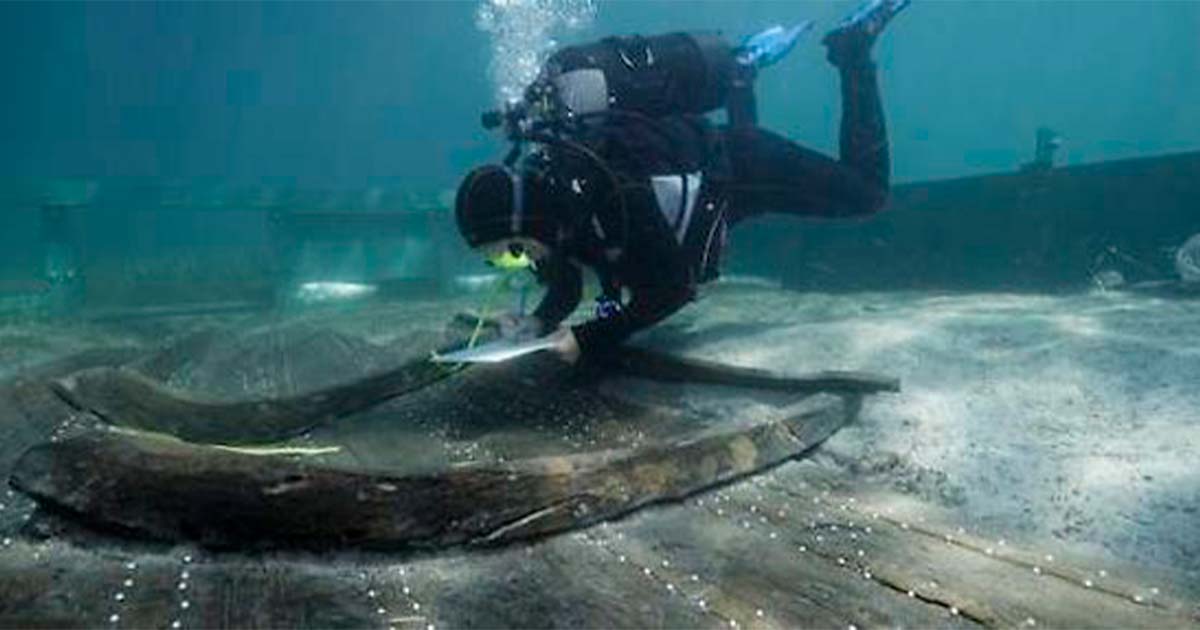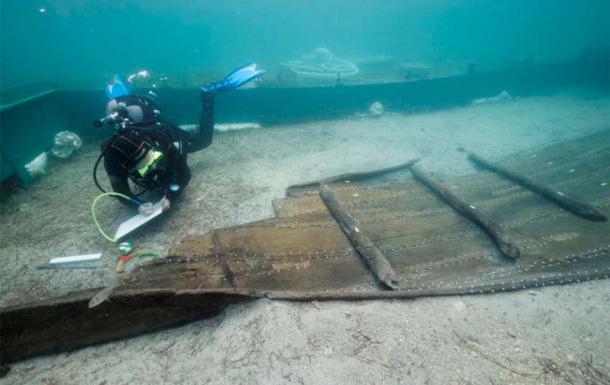 An ancient marvel is set to emerge from the depths of Croatia’s waters in the Mediterranean. Meet the Zambratija boat, a remarkable testament to maritime history that has defied the ravages of time. With seven of its twelve meters exquisitely preserved, this awe-inspiring vessel holds the key to unlocking centuries-old mysteries. Dating back to a time between the end of the 12th and the end of the 10th century BC, it proudly holds the title of the oldest entirely hand-sewn boat in the Mediterranean. Now, a skilled Franco-Croatian team from the Centre Camille Jullian and the Archaeological Museum of Istria are embarking on an extraordinary operation to lift this this rare relic of ancient shipbuilding traditions from the water and explore it in detail.
An ancient marvel is set to emerge from the depths of Croatia’s waters in the Mediterranean. Meet the Zambratija boat, a remarkable testament to maritime history that has defied the ravages of time. With seven of its twelve meters exquisitely preserved, this awe-inspiring vessel holds the key to unlocking centuries-old mysteries. Dating back to a time between the end of the 12th and the end of the 10th century BC, it proudly holds the title of the oldest entirely hand-sewn boat in the Mediterranean. Now, a skilled Franco-Croatian team from the Centre Camille Jullian and the Archaeological Museum of Istria are embarking on an extraordinary operation to lift this this rare relic of ancient shipbuilding traditions from the water and explore it in detail.
A press release by CNRS explains how on the 2nd of July 2023, a team of divers will embark on a daring mission in the picturesque bay of Zambratija, carefully removing sections of the boat. These precious fragments will then find their place in a custom support, paving the way for the meticulous reconstruction of the boat in stunning 3D detail. Through this ambitious endeavor, the scientists aim to unveil the boat’s construction date, identify the fibers employed for sewing, and unravel the secrets of wood shaping techniques used by our ancestors.

Wreck of Zambratija, Istria. Observations on the hull. (© Philippe Groscaux/Mission Adriboats/ CNRS/CCJ)
In 2014, marine archaeologist and researcher at the Centre National de la Recherche Scientifique (CNRS) in France, Giulia Boetto, announced the incredible discovery of a boat wreck in Zambratija Cove, Croatia, which was dated to 1,200 BC . The unique and rare finding was a Bronze Age sewn boat , a type of wooden boat which is literally sewn together using ropes, roots, or willow branches.
The boat wreck was first seen by fishermen in 2008, just 600 meters from the beach and only two meters below the surface, however, they believed it to be a fairly recent wreck. Giulia Boetto, and two of her Croatian colleagues, Ida Koncani from the Archaeological Museum of Istria, and her husband Marko Uhac from the Ministry of Culture, investigated the site and believed the boat to be quite old. Initial dating led to the surprise discovery that the boat was from pre-Roman times.
The research team returned to the site in 2011 to take further samples and to conduct more rigorous analyses. Finally, results of radiocarbon dating revealed that the boat dated to a much earlier period – the 12th century BC. Ms Boetto described the finding as “an extraordinary discovery [translated]”. She added, “It is extremely rare to find a wreck dating from the Bronze Age [translated]”.
- Bronze Age Ship Found in the Mediterranean is World’s Oldest Shipwreck!
- 8 Lost Shipwrecks That Still Hold Promise of Treasure and Fame

A diver vacuums sediment at the boat wreck. (Philippe Groscaux/ CNRS)
The boat measures 7 meters (23 feet) in length and 2.5 meters (8.2 feet) in width and is a sewn boat, which was a technique of shipbuilding practiced in the Adriatic until the Roman era . Sewn boat construction techniques were used in many parts of the world prior to the development of metal fasteners, and continued to be used long after that time for small boats to reduce construction costs where metal fasteners were too expensive. Carefully shaped planks are connected at the edges with overlapping sections, which are sewn together.
The remains of the boat found in Zambratija Cove are incredibly well-preserved for its age, with stitching still visible in some areas and the frame largely undamaged. The different types of wood used to construct it have been identified as elm, alder, and fir, and tree ring dating is currently underway, which will provide the date the tree was cut to the nearest year. Ms Boetto said that they hope to finalize a 3D model of the boat and, eventually, a complete reconstruction.